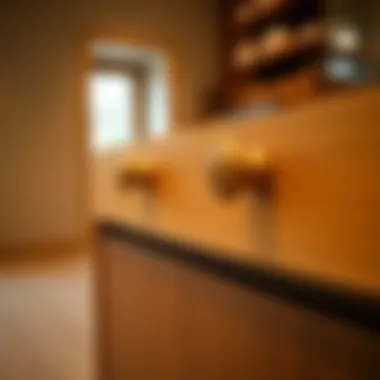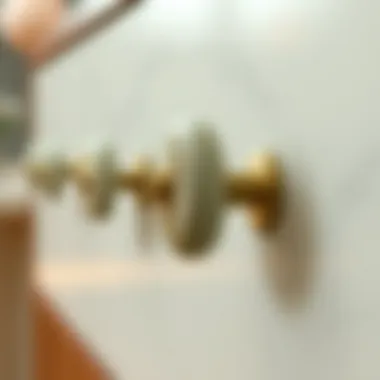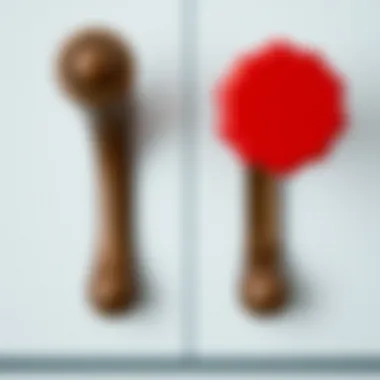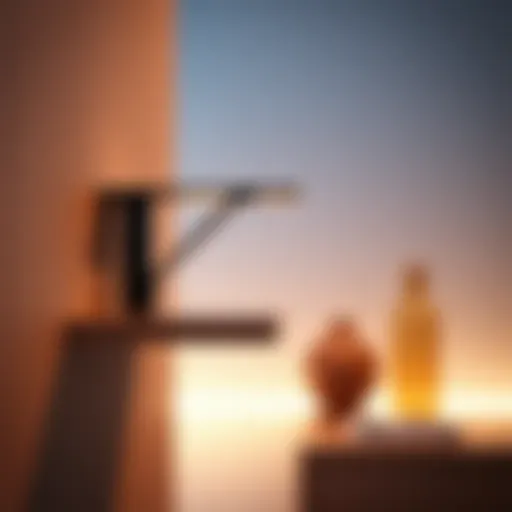Exploring the Charm of Cute Knobs in Furniture Design


Intro
When it comes to furniture design, the tiniest details often hold the most significant sway. Cute knobs, for instance, are small fixtures that can effortlessly transform an ordinary piece of furniture into a stunning focal point. They can add a dash of personality, refine an aesthetic, or even tell a story. Delving into the various materials, styles, and applications of cute knobs reveals their unique ability to enhance the overall appeal of furniture.
In this article, we will navigate through a detailed analysis of the role that these charming hardware pieces play in interior design. We will examine the current trends in furniture styles and explore ways to incorporate these trends into different spaces. For those looking to invest in cute knobs, our buying guides will assist in selecting the right fixtures for varying environments, ensuring durability and beauty.
This exploration aims to equip homeowners, designers, and DIY enthusiasts with the knowledge needed to make informed choices, encouraging them to embrace the transformative potential of cute knobs in furniture design.
Understanding Cute Knobs
In the realm of furniture design, cute knobs serve as more than just functional elements; they are the cherry on top of a well-crafted piece. Understanding the role and significance of these small fixtures is essential, particularly for homeowners and designers aiming to enhance aesthetics while ensuring practicality. Cute knobs have a unique ability to reflect personal style and contribute to the overall ambiance of a room.
When selecting furniture, buyers often concentrate on major features like color, shape, and material. However, knobs play a crucial role in tying these elements together. They can introduce contrast, add a splash of color, or provide an intricate detail that elevates the entire piece. This is especially true in pieces such as dressers, cabinets, and desks, where the knobs can capture attention and provide a focal point.
Moreover, cute knobs can also define the character of furniture. A vintage knob can impart a sense of nostalgia, while a sleek modern design can exude sophistication. Understanding how these small details contribute to the broader design narrative is key to thoughtful, impactful interior design.
Definition and Importance
Cute knobs can be defined as decorative yet functional handles or fastenings on furniture items that serve to open and close drawers, cupboards, and other compartments. Beyond their utilitarian purpose, they contribute significantly to the visual appeal of furniture. The importance of cute knobs lies in their ability to transform ordinary pieces into extraordinary ones.
For instance, consider the difference between a plain wooden drawer and one adorned with a quirky ceramic knob featuring a unique design. The latter not only serves its function but also tells a story, evokes feelings, and adds an individual touch that resonates with the occupant's personality. This capability of knobs to elevate the mundane to the magnificent cannot be underestimated in design considerations.
In summary, when delving into furniture design, recognizing the importance of cute knobs is essential, as they encapsulate a synergy of utility, style, and personalization that breathes life into residential spaces.
Historical Context
The history of knobs can be traced back to ancient civilizations, where functional elements were also crafted with a keen sense of aesthetic. In medieval Europe, for example, wooden and metal knobs were often intricately carved, not only to serve their purposes but to demonstrate craftsmanship. As furniture design evolved over centuries, so did knob designs, reflecting the prevailing styles and materials of each era.
In the mid-20th century, with the rise of mass production, knobs became more standardized, yet the artistic element remained. Designers sought to incorporate personal touches in even the simplest of fixtures, leading to the introduction of vibrant colors and diverse materials. This trend laid the groundwork for today’s playful and eclectic styles.
As we explore modern furniture design, the historical development of knobs provides a rich context. It underscores their evolution from purely functional objects into essential design components, echoing how tastes and material technologies have shifted. Each knob carries with it not just a function but a piece of history, merging the past with contemporary design sensibilities.
"Small details make a big difference; knobs are a testament to this design philosophy."
Materials Used in Cute Knobs
The subject of materials used in cute knobs holds significant weight in the realm of furniture design. The choice of material not only influences the aesthetic appeal but also impacts the durability and overall functionality of the knobs. Homeowners, designers, and craft enthusiasts can all benefit from understanding these materials better. Whether it's the warmth of wood or the sleekness of metal, each material brings its own set of characteristics that can transform furniture, making it both practical and visually enchanting.
Wooden Knobs
Wooden knobs convey a sense of warmth and rustic charm, making them a popular choice, especially in traditional and shaker-style furniture. Crafted from various timbers like oak, maple, or cherry, wooden knobs can be finished in a multitude of ways. Some might prefer a lacquered sheen that emphasizes the wood grain, while others may opt for a matte finish for a more natural appearance. This attention to detail can breathe life into a cabinetry or dresser, ensuring that every piece tells its own story.
Additionally, wooden knobs are often easier to shape and carve, allowing for intricate designs that resonate with different decor styles. They can be stained in an array of colors, offering flexibility in matching existing furniture or creating a focal point. However, they do require some maintenance to prevent wear and tear, especially in humid environments, which is something to consider.
Metallic Knobs
Shiny, reflective, and undeniably stylish, metallic knobs can add a modern edge to furniture. These knobs come in various metals, including brass, bronze, and stainless steel. The durability of metal makes it a choice that withstands daily use without significant degradation.
From the industrial look of brushed nickel to the rich hues of aged brass, metallic knobs are versatile enough to fit in with both contemporary and vintage styles. However, it's important to note that metal knobs can sometimes become warm to the touch in high-temperature environments, making it worthwhile to consider placement carefully.
In terms of design, metallic knobs can be simple and sleek or ornate and decorative. The choice of metallic finish, such as matte, polished, or antique can also enhance the visual appeal, ensuring that these knobs are not just functional but also fashionable.
Ceramic and Porcelain Knobs
Ceramic and porcelain knobs introduce a delightful pop of color and intricate patterns to furniture. Available in an extensive range of designs, these knobs can be hand-painted or molded into vibrant shapes, catering to a wide variety of tastes. They are particularly fitting for farmhouse or bohemian decor, where their unique motifs can add character to otherwise simple cabinetry.
Ceramic knobs are generally sturdy but should be handled with care to avoid chipping. Despite their fragility, they offer limitless design possibilities, from floral patterns to geometric shapes, giving designers multiple avenues to express creativity.
Glass Knobs
For those seeking a touch of elegance, glass knobs can elevate the simplest furniture pieces into something extraordinary. With their transparency and ability to catch light, glass knobs add an airy quality to any setting. They can come in a range of styles, from clear to colored glass and from faceted to smooth surfaces, thus easily complementing any design theme.
Glass knobs require less maintenance than wood, but they may also be more susceptible to breakage if handled roughly or if installed on high-traffic cabinets. Still, their visual appeal often outweighs these considerations, making them a favored option for statement pieces in homes.
Eco-friendly Materials
In an age where sustainability is paramount, eco-friendly materials are gaining traction in knob design. These can include sustainably sourced woods, recycled metals, and biodegradable composites. Utilizing these materials not only reduces environmental impact but also promotes a green lifestyle that many homeowners prioritize.
Products made from eco-friendly materials can convey a conscientious design philosophy, often without sacrificing aesthetics or durability. For instance, bamboo knobs offer a unique blend of strength and softness, presenting a warm but environmentally friendly option.
Choosing eco-friendly materials for knobs can also align with other sustainable practices in home decor, drawing attention to the growing demand for responsible consumption.
Understanding the materials used in cute knobs is essential for ensuring that designs are not just appealing but also practical and reflective of the values of homeowners today.
Design Styles Featuring Cute Knobs
Cute knobs are more than just functional elements; they are the jewelry of furniture design. The right knob can tie a room together, echo its style, and offer a breath of fresh air to an otherwise mundane piece. Each design style tells its own story, and the knobs selected play a vital role in conveying those narratives.
When choosing knobs, understanding the context of design styles can help homeowners and designers alike make choices that enhance the aesthetic appeal of their spaces. Beyond mere decoration, these small features can elevate functional furniture into a work of art while providing insight into personality and character of the space. Here's a deeper look into the various styles that showcase the charm of cute knobs.


Bohemian Decor
Bohemian decor is all about creativity, freedom, and a mix of different cultures. This style thrives on the concept of layering colors, textures, and patterns, where cute knobs can be both a focal point and an accent. Think of vividly colored ceramic knobs adorned with intricate patterns or a whimsical shape that catches the eye.
In bohemian spaces, knobs can complement a variety of materials from natural wood to rich textiles. A colorful knob can stand out on a salvaged side table or cabinet, drawing attention to the artistry of the piece itself. They reflect the carefree spirit that defines the bohemian lifestyle.
Mid-Century Modern
Mid-century modern design plays on clean lines and functional forms, where each element is carefully considered. In this context, cute knobs take on a minimalist approach, often using materials like polished brass or sleek bakelite. Here, the simplicity of the knob acts as a statement, emphasizing the overall structure of furniture pieces without overwhelming them.
Homeowners looking to incorporate mid-century modern influences might opt for knobs shaped in geometric forms or those that feature muted colors. These knobs meld function with aesthetic easily, ensuring practicality while remaining true to the design ethos.
Rustic Style
Rustic style embodies a warm and inviting atmosphere, often inspired by nature. This design style is characterized by reclaimed wood, natural textures, and an earthy color palette. Cute knobs in this context often embrace organic shapes and materials, such as wooden knobs or antique metal fixtures that feel at home in a log cabin or a farmhouse.
Knobs with a patina finish or those that are handmade can add a touch of authenticity. They serve not just as practical features, but as elements that carry a story or a history on your furniture. If you want to evoke feelings of comfort and nostalgia, choosing the right rustic knob can enhance this aesthetic significantly.
Contemporary Trends
Contemporary design is ever-evolving, favoring innovation and fresh perspectives. Options for cute knobs in this realm can range from sleek glass knobs to artisanal hand-painted designs. They are often selected not just for their function, but also for their artistry and uniqueness, allowing them to become unexpected conversation starters.
Moreover, sustainability is emerging as a critical factor in contemporary trends. Designers may gravitate towards eco-friendly materials for knobs, such as recycled metals or sustainably sourced woods. Integrating these choices supports a broader commitment to environmental consciousness in furniture design.
"In furniture design, knobs are like the finishing touch; a small detail that can change the entire look and feel of a piece."
Functional Aspects of Cute Knobs
Cute knobs serve not just as mere adornments for furniture but also encapsulate a host of functional benefits that enhance user experience and add longevity to the pieces they grace. Their importance cannot be overstated, as they contribute significantly to the design, usability, and safety of furniture. Delving into the functional aspects, we find that ease of use, durability and maintenance, along with safety features, form the crux of what makes cute knobs not only charming but practical as well.
Ease of Use
When it comes down to it, one of the foremost functions of knobs is their role in making furniture accessible. A cute knob can transform a cumbersome cabinet into an inviting space, facilitating ease of access to its contents. For instance, a well-placed ceramic knob on a kitchen cupboard can make all the difference when you’re in the middle of cooking. Consider designs with larger surfaces or those that are textured, as they provide a grip that’s friendly for fingers.
- Aesthetic and Accessibility: A knob's style can either enhance or detract from usability. While something ornate may catch the eye, its usefulness might be lacking if it’s difficult to grip.
- Consider Designs: Think about designs that stand out but are also practical. Knobs with a slight curve or those that are slightly angled can help provide leverage.
Durability and Maintenance
Cute knobs are often crafted from a variety of materials, influencing how often they need replacing or repair. In the hands of a discerning homeowner or designer, the choice of knob should factor in not just design but also the wear and tear they will undergo. For instance, wooden knobs can ooze charm but might require more upkeep than their metallic counterparts.
- Longevity: Metal knobs designed from alloys or brass usually offer a sturdier solution and tend to withstand the test of time.
- Cleaning Tips: Maintenance can be simple. For instance, glass knobs can be wiped down with a damp cloth, while wooden knobs may benefit from occasional oiling to keep the wood vibrant.
Safety Features
Safety should never be overlooked, especially in homes with children or pets. Knobs need to be designed in a way that minimizes the risk of accidents. Rounded edges and smooth surfaces can help prevent injuries. For example, a rounded knob design on a dresser can be much safer than a pointy one, lessening the chance of bumps and bruises.
- Child-Friendly Designs: Some knobs even come with soft edges specifically created to be safe for curious little hands, ensuring a stylish yet secure environment.
- Quality Construction: Choose knobs made from standard materials that do not easily break. A shattered knob might lead to sharp edges, becoming a hazard.
"In other words, while aesthetics play a significant role in furniture design, functionality serves as the soul that keeps our environments practical and safe."
In summary, the functional aspects of cute knobs embody much more than meets the eye. Ease of use means accessibility in everyday tasks, while durability and maintenance ensure that your selected styles not only please the eye but serve effectively over time. Lastly, opting for designs prioritizing safety is essential for creating a worry-free space. Choosing the right knobs involves balancing charm with these vital considerations, thus enhancing the overall furniture experience.
Choosing the Right Cute Knob
In the world of furniture design, the selection of hardware often goes unnoticed, despite its pivotal role in shaping aesthetics and functionality. Cute knobs, in particular, are tiny accents that can turn ordinary furniture into extraordinary pieces. Their impact lies within their capability to complement the overall style while enhancing usability. With a virtually endless array of designs, materials, and colors, making the right choice can feel overwhelming, yet it’s essential. Not only do the knobs serve a practical purpose, but they also contribute significantly to the unique character of a space.
Matching Style and Functionality
When choosing a cute knob, it’s important to first align it with the overall style of the room. Imagine a modern kitchen engulfed in sleek lines paired with antique-like ceramic knobs; the combination clunks like a bad note in a symphony. Conversely, consider a rustic farmhouse using reclaimed wood knobs in a distressed finish—these details can beautifully tie a room together.
Functionality shouldn’t take a backseat either. It doesn’t matter how charming a knob looks if it’s hard to grasp or doesn’t function well. Selecting knobs that blend style with easy use enhances your space. Make sure the size and shape work well with how people will interact with them. The following aspects are worth keeping in mind:
- Style Consistency: Ensure the knob matches furniture design. For a minimalist setup, choose simple, understated knobs. In a maximalist approach, try bold colors and intricate designs.
- Material Suitability: For heavy doors, metal knobs may provide the necessary strength without compromising design.
- Ergonomics: Choose knobs that feel comfortable in hand; unusual shapes may look good but often don't serve their purpose well.
Color Coordination
The color of your cute knob can either make or break the look. It's like dressing a cake; the frosting can elevate its appeal or clash with the flavors. Selecting a hue that complements or contrasts the furniture is vital. One could select a knob that matches existing colors in the room, pulling a color from a nearby textile or wall. Alternatively, using knobs as statement pieces can be an effective strategy to draw the eye.
Some considerations with color include:
- Monochromatic Palettes: Stick to shades of one color for a cohesive, tranquil vibe.
- Bold Contrasts: A bright yellow knob on a serene gray cabinet creates a vibrant focal point.
- Natural Tones: Earthy colors, like greens and browns, can warm up a neutral space.
"Color is like a language, it speaks directly to the emotions. Play with it wisely!"
Size Considerations
Size matters—there’s no getting around it. A knob too small can get lost against massive wooden doors, whereas one too large might seem overwhelming on delicate drawers. You want balance; think of it like accessorizing an outfit. A well-sized cute knob should feel proportional to the piece of furniture it decorates, enhancing without overpowering.
Things to keep in mind:
- Proportions: Large cabinets need larger knobs for a harmonious look, while petite furniture can benefit from smaller, daintier ones.
- Accessibility: If knobs are too small, they can impede usability, especially for children or those with mobility challenges.
- Style Density: Too many small knobs can easily clutter the aesthetic; instead, opt for fewer, more prominent designs.


Choosing the right cute knob relies on your ability to mix and match factors like style, color, and size. A discerning eye can appreciably enhance both the look and practicality of your furniture, ultimately making your home a reflection of your personal style.
Installation Tips for Cute Knobs
When it comes to adding those charming cute knobs to furniture, thinking about installation is just as important as the aesthetic choice itself. A well-installed knob not only enhances the overall look of the piece but also ensures the functionality of the drawer or cabinet. Whether you're refreshing a vintage dresser or assembling a brand new piece of furniture, knowing the ins and outs of installation can save headaches down the road.
In this section, we’ll cover essential tools needed for the job, a straightforward step-by-step process to follow, and common pitfalls to steer clear of. Following these tips will help homeowners, designers, and DIY enthusiasts achieve professional-looking results.
Tools Required
The right tools can make all the difference when installing cute knobs. Having everything ready and at hand ensures a smooth process without unnecessary hiccups. Here’s a list of essentials to gather before you get started:
- Screwdriver: Depending on the type of screws provided with the knobs, you may need either a Phillips or flat-head screwdriver.
- Drill with drill bits: For those fitting knobs onto thick or particularly stubborn surfaces, a drill will make the task a breeze.
- Measuring tape: Precision is key, so having a tape measure ensures that your knobs are placed perfectly.
- Pencil: Marking spots for drilling with a pencil helps avoid mistakes.
- Level: To make sure each knob sits perfectly in alignment, especially on larger pieces.
Step-by-Step Installation Process
- Measure and Mark: Start by measuring the spot where you want to install the knob. Use a pencil to mark the center point accurately, ensuring a pleasing layout.
- Confirm Alignment: After marking, use a level to double-check that your marks are straight. This step prevents any crooked knobs from ruining the look.
- Drilling: If you’re working with wood or another material that might need pre-drilled holes, carefully drill into the marked spots. Use the appropriate drill bit size that matches the screw dimensions.
- Install the Knob: Align the knob’s base with the drilled hole, inserting the screw from inside the drawer or cabinet. Tighten it with a screwdriver, ensuring it sits securely—don’t tighten too much, risking damage to the material.
- Final Check: Once installed, give the knob a gentle tug to make sure it’s firmly in place. If it wobbles, consider adjusting the screw slightly or re-tightening it.
By following these steps, you ensure that the knobs not only look fantastic but are also functional and securely fastened to your furniture.
Common Mistakes to Avoid
While installing cute knobs, there are some common missteps that even seasoned DIYers can make. Here’s what to watch out for:
- Ignoring Measurements: Skipping the measuring step can lead to uneven placements. Measure twice, drill once should always be the mantra.
- Using the Wrong Drill Bit: Always double check that the drill bit size is appropriate for the screws you're using. An incorrect size can cause the screw to strip or wobble, leading to a weak installation.
- Over-tightening the Screws: It’s tempting to wrench those screws tight, but it can sometimes crack the materials, especially in softer woods or finishes. Just a firm grip is usually enough.
- Not Matching Hardware with Style: Make sure the chosen knobs align with the hardware style of the furniture. An ornate knob might look silly on a minimalist piece.
"Precision and patience are the cornerstones of a well-executed installation. With the right preparation, you can transform furniture easily."
By avoiding these mistakes and applying the installation tips mentioned, your knobs will not only be beautiful additions but will also function with grace. The journey doesn’t end here, as understanding maintenance and care is equally vital for long-lasting charm in the future.
Trends in Cute Knob Design
In the ever-evolving landscape of furniture design, the humble cute knob has gained prominence as a crucial facet. Beyond mere functionality, these elements serve as miniature artistic expressions, reflecting not just individual style but also current design trends. The significance of understanding these trends lies in their potential to elevate furniture pieces from ordinary to extraordinary. This section explores various trends, highlighting the multidimensional role cute knobs play in shaping modern interiors.
Innovative Designs
Innovative designs in cute knobs are not just about aesthetics; they often incorporate thoughtful engineering and creativity. Today’s knobs come in various shapes, sizes, and finishes, such as geometric forms or playful animal shapes that resonate with a broader audience. Think about a cabinet featuring knobs shaped like whimsical clouds or vibrant floral motifs; they can bring a certain liveliness to a room.
Moreover, the integration of technology in knob design is on the rise. Smart knobs that glow or react to touch represent a fusion of functionality and modern technology, paving the way for intuitive home design.
Here are some innovative approaches seen in the market:
- Dual-Functionality: Some designs now incorporate storage options within the knob, useful for hiding small items.
- Switch Knobs: Knobs that can function as light switches, seamlessly merging beauty and purpose.
- Artisan Collaborations: Designers collaborating with local artisans to create unique, hand-crafted knobs that tell a story.
Customization Options
Customization is another key trend currently taking the forefront in knob design. As homeowners seek to personalize their spaces, the option to customize knobs allows for bespoke touches that cater to individual tastes and preferences. Custom knobs can be tailored not just in terms of color but also in design motifs, materials, and dimensions.
More businesses are offering platforms where customers can choose designs that reflect their personal aesthetics, creating a connection between the user and the product. Options include:
- Color Selections: Picking finishes ranging from matte to glossy, allowing knobs to either blend in or stand out.
- Engraving: Adding names, dates, or meaningful phrases to make a knob uniquely yours.
- Unique Shapes: Crafting knobs that fit specific themes, like nautical, retro, or minimalist styles.
"Customized details in designs make a space feel more like home," states Linda Kreiger, a furniture designer based in Portland.
Sustainability in Knob Design
The growing concern for environmental impact has brought sustainability into the spotlight in furniture design. Sustainable knob design involves using eco-friendly materials and processes that reduce environmental footprints. Many manufacturers now focus on responsibly sourced wood, recycled metals, or biodegradable materials, signaling a shift towards greener practices.
Designs embracing sustainability often include:
- Natural Finishes: Using non-toxic varnishes or stains to enhance the natural beauty of wood without harming the environment.
- Reclaimed Materials: Repurposing items to create knobs that not only look unique but also come with a story.
- Certifications: Knobs that meet certain eco-standards, offering peace of mind to environmentally conscious consumers.
In summary, the trends in cute knob design are reflective of broader societal movements towards innovation, personalization, and sustainability. Embracing these trends can elevate both the design value and functional aspects of furniture, making them not just decorative elements, but symbols of an evolving aesthetic culture.
Where to Buy Cute Knobs
Finding the right cute knobs can significantly enhance your furniture and your overall decor. This section discusses the essential avenues for purchasing these charming accents. From online platforms to local shops, understanding where and how to buy cute knobs is crucial for homeowners and designers alike. Each option offers its own set of benefits and considerations, making it essential to know the landscape of choices available.
Online Retailers
In today's digital marketplace, online retailers have become go-to sources for a plethora of cute knob options. Platforms like Amazon and Etsy teem with various designs and materials, making it convenient to browse from the comfort of your home. One major plus of shopping online is the sheer variety. You can find unique or vintage styles that may not be available in physical stores.
Moreover, most online retailers provide customer reviews, which can guide your decision-making. Just ensure that you're buying from reputable sellers to guarantee quality. For example, look for those with good ratings and positive feedback. Additionally, many online stores allow you to filter search results by style, material, or price, making it a breeze to find exactly what you want.
Local Craft Shops
Local craft shops are treasure troves for those who love personality in their decor. When you visit a shop, you not only get to see the knobs in person, but you can also feel the quality of the materials. This tactile experience can be invaluable when choosing knobs that you'll be using for years.
In these shops, you often find handcrafted options that reflect local artistry. This uniqueness can add a special touch to your furniture. Plus, visiting these stores supports local businesses, contributing to the community's economy. Don't hesitate to ask the staff for recommendations based on your design needs; they can offer insights that an online search cannot.


Custom Design Services
If you're seeking something truly one-of-a-kind, custom design services might be your best bet. Engaging with skilled artisans allows for a personalized approach to your knob design. Whether you want to incorporate specific themes or colors, custom services provide tailored solutions that fit your vision perfectly.
The downside here is usually a higher cost and longer lead times compared to mass-produced options. However, the result is a set of knobs that are not just functional but also art pieces that tell a story through design. Contact local artisans or find services online that specialize in custom home decor to explore this avenue.
"Investing in unique knbs is like giving your furniture a voice; it tells the story of who you are."
Maintaining Your Cute Knobs
Keeping your cute knobs in tip-top shape isn't just about looks; it also plays a big role in the overall longevity and function of your furniture. After all, those petite embellishments are the first to catch the eye, and well-maintained knobs can elevate the aesthetic of even the most mundane drawers and cabinets. Regular maintenance ensures that their charm continues to shine, while also safeguarding the integrity of the furniture they adorn. Let’s roll up our sleeves and dive into how to keep these delightful details looking their best.
Cleaning Techniques
Cleaning your cute knobs might seem straightforward, but tailored methods for different materials can make all the difference. Here’s a rundown on how to tackle cleaning for various knob materials:
- Wooden Knobs: Gently wipe with a soft, damp cloth and mild soap. Avoid soaking as moisture can warp the wood.
- Metallic Knobs: A mix of vinegar and water in equal parts can help remove tarnish. Use a microfiber cloth to buff to a shine afterward.
- Ceramic and Porcelain Knobs: These are usually easy to clean with a soft sponge and warm, soapy water. Make sure to dry thoroughly to prevent water spots.
- Glass Knobs: Use a glass cleaner or a vinegar-water mixture to get rid of fingerprints and smudges. Just don’t go crazy with abrasive scrubs.
- Eco-friendly Options: For those leaning towards sustainable solutions, baking soda mixed with water can create a gentle paste. Apply it for a deeper clean, allowing it to sit for a few minutes before rinsing.
Maintaining cleanliness is not just about looking good; it can also prevent buildup that may damage the finish or the mechanical elements of the knobs over time.
Keeping your knobs clean is key to ensuring their functionality and beauty. A little effort goes a long way in preserving their charm.
Repair and Replacement
Sometimes, despite your best efforts, knobs might encounter sturdier foes—like a toddler’s exuberance or an overly enthusiastic cleaning sponge. Knowing when to repair or replace can save you time and money in the long run.
Repairing Knobs
- Loose Knobs: It’s common for knobs to become wobbly over time. A simple tightening with a screwdriver can often resolve this. Check if the screw is stripped—if so, consider using a larger screw or wood glue to reinforce it.
- Scuffed Finishes: For wooden knobs with minor scratches, a little sandpaper followed by polish can help rejuvenate their appearance. For painted knobs, a touch-up paint can work wonders to cover up imperfections.
When to Replace
- If a knob is cracked, especially in ceramic or glass versions, a replacement is likely the best option. Not only does it ensure safety, but it preserves the overall appearance of your furniture.
- If the design no longer matches your aesthetic—style evolves, and it’s completely alright to update your hardware to reflect new trends or personal taste.
- Additionally, consider swapping out knobs during a home remodel. A fresh set of cute knobs can make old furniture feel brand new again.
Case Studies and Examples
The importance of case studies and examples in exploring cute knobs in furniture design cannot be overstated. They serve as a lens through which the impact of small design choices can be appreciated and understood. By analyzing real-life applications and transformations, readers can see firsthand how these seemingly minute details elevate the aesthetics and functionality of furniture. Each case study not only showcases creativity but also provides practical insights that can inspire homeowners and designers alike.
Considerations include:
- Real-world Impact: Observing successful implementations can spark new ideas.
- Design Techniques: Learning about techniques used in transformations can help in planning future projects.
- Material Choices: Understanding which materials work best in various settings offers direction in product selection.
Successful Transformations with Cute Knobs
Take, for instance, a quaint kitchen that once featured plain, outdated cabinet knobs. The homeowner, passionate about cozy, rustic design, decided to switch to handcrafted wooden knobs adorned with intricate carvings. The transformation was nothing short of stunning.
The new knobs not only matched the farmhouse aesthetic but also created a seamless blend between old and new elements. The tactile experience of the wooden knobs added warmth that was previously missing. They became conversation starters, bridging the gap between the kitchen’s functionality and its charm.
Another excellent example is a modern bathroom renovation where sleek ceramic knobs were incorporated into minimalist cabinetry. The glossy finish provided an elegant contrast to matte surfaces, enhancing both style and usability. The transformation illustrated how knobs can dictate the room's tone, infusing it with personality without overpowering it.
Designer Spotlights
Highlighting innovative designers who prioritize the use of cute knobs in their work reveals how influential these small components can be. One standout is Julia Stotz, known for her contemporary approach to vintage furniture. Her recent collection features quirky glass knobs that mimic natural forms, such as seashells and pebbles, bringing a touch of nature into urban spaces.
Then there’s David Trubridge, who emphasizes sustainability. His cabinet knobs crafted from reclaimed timber not only serve a purpose but tell a story. This thoughtful approach turns each knob into a piece of art, marrying function with environmentally-conscious design.
These designers showcase that cute knobs are not mere accessories; they are integral to crafting a cohesive story within the home.
"Design is not just what it looks like and feels like. Design is how it works." – Steve Jobs
To keep up with the design innovations, it's beneficial to explore platforms such as reddit.com for feedback and user experiences regarding cute knobs in furniture design. Engaging with communities can also yield additional inspiration and practical tips.
Ending: The Impact of Cute Knobs
As we wrap up this discussion on cute knobs, it's important to recognize their dual role in both functionality and aesthetics. Cute knobs are not just trivial embellishments; they are the delightful finishing touches that can transform ordinary furniture into extraordinary pieces of art. These small features might seem insignificant at first glance, yet they carry substantial weight in the overall design narrative of any space.
One of the key impacts of cute knobs lies in their ability to convey personality and style. Homeowners and designers can curate a particular atmosphere by selecting knobs that align with broader design themes, whether it’s vintage charm, modern minimalist, or rustic coziness. In essence, these knobs become reflections of individual taste. When one carefully chooses knobs, it makes a statement that rings true in the entire design narrative.
Moreover, cute knobs often showcase craftsmanship and creativity, lending a unique touch to furniture that mass production often lacks. By opting for artisanal designs, one supports local artisans and encourages a market that values originality over uniformity. This shift towards handmade or thoughtfully designed knobs can even inspire other design elements in a home, creating a more cohesive aesthetic.
Additionally, there’s a distinct functional aspect to these knobs. They enhance usability—after all, pulling open a drawer or cabinet can be a pleasure when the pulls are attractive and inviting. Functionality, in this case, meets form in a beautifully orchestrated dance. Furthermore, the durability and material choices in knobs directly affect the longevity of furniture. Choosing high-quality knobs can significantly extend the life of cabinets and drawers.
When it comes to design decisions, considering cute knobs brings both joy and practicality. Homeowners must weigh their personal preferences against trends; these knobs should fit the desired look while also serving their purpose effectively. Evaluating aspects like size, material, and color harmony ensures that whatever knob is chosen not only fits the piece aesthetically but also integrates seamlessly into the daily lived experience. Whether it’s in the kitchen, bathroom, or living area, the right knobs can make all the difference.
"Cute knobs are the understated heroes of furniture design—small yet mighty in their impact, guiding style choices and enhancing usability."
In the end, an investment in cute knobs is an investment in the heart of one’s living space. After all, a home is not merely a collection of furniture; it’s a manifestation of one’s identity and a canvas for self-expression. Thus, as we conclude this exploration, just remember that every detail counts, and cute knobs embody this philosophy beautifully.
Final Thoughts on Design Choices
In reflection, the choice of knobs should resonate with the specific character of the room. For instance, if aiming for a casual, laid-back feel, whimsical, colorful knobs might work wonders. Alternatively, chrome or brass knobs may suit a high-end contemporary space. It’s about finding that sweet spot between function and aesthetic appeal.
Here are some key considerations when making your choices:
- Reflect Personal Style: Choose knobs that tell a story about you and your environment.
- Consider the Overall Theme: They should complement furniture styles rather than clash.
- Functionality Matters: Prioritize usability and comfort along with visual appeal.
Ultimately, each selection shapes the overall atmosphere, so take the time to explore and appreciate the unique charm cute knobs can bring to furniture design.















